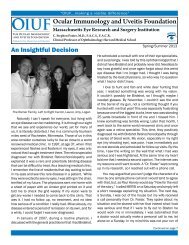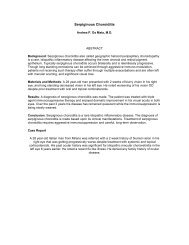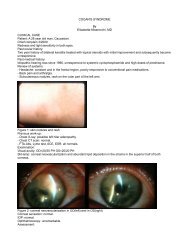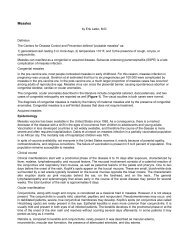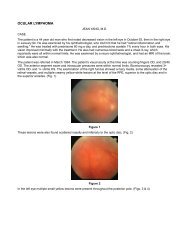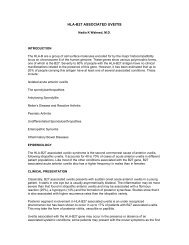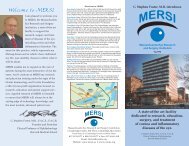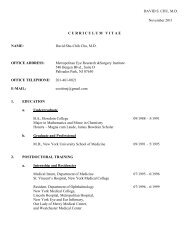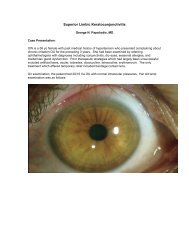Ocular Sarcoidosis - Ocular Immunology and Uveitis Foundation
Ocular Sarcoidosis - Ocular Immunology and Uveitis Foundation
Ocular Sarcoidosis - Ocular Immunology and Uveitis Foundation
You also want an ePaper? Increase the reach of your titles
YUMPU automatically turns print PDFs into web optimized ePapers that Google loves.
Figure 7. Bilateral symmetrical gallium uptake by the lacrimal, parotid, <strong>and</strong> subm<strong>and</strong>ibular gl<strong>and</strong>s (P<strong>and</strong>a sign).<br />
Angiotensin converting enzyme (ACE)<br />
ACE is normally present in the vascular endothelium of many organs (lung, kidney, small intestine, uterus, prostate,<br />
thyroid, testes, adrenals) <strong>and</strong> in macrophages. The latter source accounts for elevated ACE levels in patients with<br />
sarcoidosis. The induction of ACE synthesis in epithelioid cells <strong>and</strong> macrophages is caused by a soluble ACEinducing<br />
factor (AIF). ACE is elevated in 60-90% of patients with active sarcoidosis. A normal serum ACE does not<br />
exclude the diagnosis, especially if the disease is in its early stages, localized to a small area (e.g. the eye), <strong>and</strong><br />
therefore with a small epithelioid cell "barden". False low values are also measured in patients taking ACE inhibitors<br />
or in patients with endothelial abnormalities, such as deep vein thrombosis, <strong>and</strong> in patients who have had<br />
chemotherapy or radiation. Treatment with systemic steroids or other immunosupressive agents can also affect<br />
ACE levels with values normalizing with adequate control of intraocular inflammation. Other disorders associated<br />
with elevated serum ACE include Gaucher's disease, leprosy, chronic pulmonary disease, rheumatoid arthritis,<br />
spondylitis, primary biliary cirrhosis, tuberculosis, histoplasmosis, histiocytic medullary fibrosis, hyperthyroidism <strong>and</strong><br />
diabetes mellitus.<br />
Pulmonary function tests<br />
Pulmonary function tests are useful in the initial diagnosis <strong>and</strong> follow up of patients with sarcoidosis. Their<br />
sensitivity in disease with <strong>and</strong> without roentgen evidence of parenchymal involvement has been reported as 70%<br />
<strong>and</strong> 40% respectively. The most common abnormalities seen early in the course of the disease are a post exercise<br />
increase in the alveolar-arterial oxygen gradient <strong>and</strong> diffusing capacity <strong>and</strong> a reduction in lung compliance.<br />
Bronchoalveolar lavage (BAL)- Transbronchial lung biopsy (TBLB)<br />
The earliest pathologic finding in patients with sarcoidosis is a mononuclear alveolitis composed of increased CD 4<br />
+<br />
lymphocytes (with an increased CD 4<br />
/CD 8<br />
ratio), monocyte-macrophages, <strong>and</strong> rare B lymphocytes. Tissue for<br />
biopsy from the bronchial mucosa or the adjacent lung is obtained through a fibreoptic bronchoscope. Non<br />
caseating granulomas have been reported in 54-88% of patients who underwent TBLB.The rate of positive findings<br />
by TBLB is higher in patients with radiologic evidence of pulmonary infiltration, <strong>and</strong> is approximately 60% among<br />
patients with hilar lymphadenopathy whose chest radiographs show normal lung parenchyme.<br />
Hypercalcemia<br />
Hypercalcemia has been reported in 10-15% of patients with sarcoidosis <strong>and</strong> is related to increased serum<br />
concentrations of 1,25-dihydroxy-vitamin D 3<br />
(calcitriol). Calcitriol is produced at sites of active disease by alveolar<br />
macrophages <strong>and</strong> possibly T lymphocytes. Elevated serum levels of calcitriol in hepercalcemic patients with<br />
sarcoidosis lead to increased absorption of calcium <strong>and</strong> phosphate from the gastrointestinal tract which leads to<br />
hypercalcemia <strong>and</strong> hypercalciuria.<br />
Lysozyme<br />
Lysozyme is an enzyme normally secreted by monocytes <strong>and</strong> polymorphonuclear leukocytes. Several reports have<br />
shown that the levels of serum lysozyme are raised in patients with sarcoidosis <strong>and</strong> may be related to disease<br />
activity. Raised lysozyme levels have been reported in parallel to raised serum ACE levels. It is thought that the<br />
epithelioid cell of the sarcoid granuloma is the source for both lysozyme <strong>and</strong> ACE.



